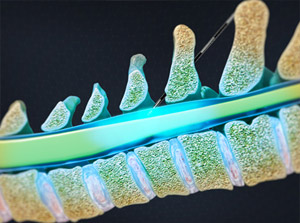Epidural Injections
Call (703) 520-1031 or use the form below to send us your contacts.

The epidural space is a space that exists in the spine within the spinal canal. This space lies between two planes of tissue: the sac of connective tissue that surrounds and protects your spinal cord (dural sac) and the vertebral bones. The epidural space contains fatty tissue, nerve roots and blood vessels. Sometimes these nerves can be compressed in the spinal canal, causing inflammation and pain. Potential causes of this include herniated discs into the epidural space, a narrowing of the spinal canal called spinal stenosis and degeneration of intervertebral disc and facet joints.
What is an epidural steroid injection?
An epidural steroid injection can be used to confirm the source of the pain and to achieve therapeutic relief. Common conditions for which this procedure can be performed include disc herniation, spinal stenosis, degenerative disc disease, post-herpetic neuralgia, post-laminectomy syndrome and vertebral compression fractures.
Steroids can be injected into your epidural space under fluoroscopy guidance that is necessary for accuracy and safety of the procedure. When your doctor performs this procedure in the portion of the spine responsible for neck and arm pain, the procedure is called a cervical epidural steroid injection. When it is performed in the portion of the spine that is causing mid-back, chest or abdominal wall pain, it is called a thoracic epidural steroid injection. Finally, when it is performed in the part of the spine causing lower back pain, the procedure is called a lumbar epidural steroid injection.
The procedure is carried out in the following way:
Doctor will ask you to lie on your stomach. The injection area will be cleaned and sterilized. Then, your doctor will inject a local anesthetic to numb the skin and to ease painful feelings during the procedure. After that, a needle will be guided into the targeted epidural space with X-ray guidance. In addition, contrast substance will be injected to confirm the proper spread of medications into your epidural space. Then your doctor will inject steroids into the epidural space through the needle. Steroids (cortisone) have a potent anti-inflammatory effect which can provide substantial reduction of nerve pain. Finally, your physician will remove the needle and apply a sterile dressing.
Risks of Epidural Steroid Injections
Like all invasive procedures, epidural steroid injections have potential risks of complications. They include:
Infection. This is a rare complication, happening in only about one percent of patients.
Dural puncture. This happens in about fifty percent of injections. You may have a spinal headache that will go away within a few days.
Bleeding. This rare incidence happens more often in patients who have bleeding disorders.
Nerve damage. Nerve damage or bleeding may happen where the needle was injected; however, it is an extremely rare complication.
Side effects
You may have some side effects from the procedure including anxiety, facial flushing, headaches, pain in the area, sleeplessness, fever, stomach ulcers, cataracts, increased blood sugar and lowered immunity.
